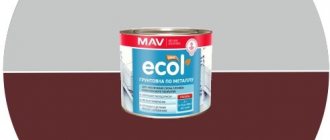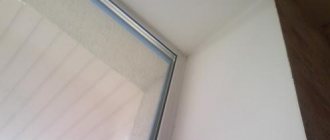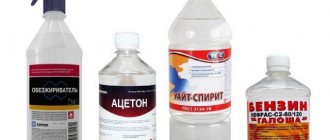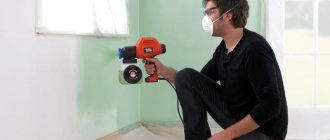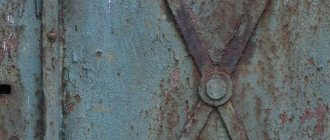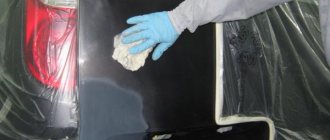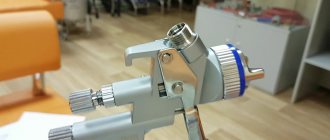Features of painting work in winter
In industrial conditions, the need for painting at low temperatures arises if the object needs to be delivered on time, or if there is an urgent need to renew the surface of the building. In everyday life, such urgency is rarely observed, but it still happens. There are a number of features of painting in the cold season:
- The most unfavorable temperature for using paints, enamels and primers in winter is from minus 5 degrees to plus 5 degrees. It’s better to work even in cold weather, because it is in the specified range that condensation will form on any surface. In the presence of moisture, the adhesion of the coating greatly deteriorates and the properties of the paints change. The quality of the coating decreases and it will not last long.
- If you decide to paint facades in cold weather, you need to remember that facade paint of any brand takes 2-3 times longer to dry than in warm weather. To get a high-quality coating, you need to use a heat gun for drying or stretch the film over scaffolding.
- You should choose only enamel and primer suitable for the winter season. Using the wrong material will cause it to freeze, and the ice will prevent the product from being applied to the walls. The final result of the work depends on the quality of the paint.
A number of modern paints are perfectly applied at zero temperatures and in frost, some can be used down to –20 degrees. There are good products that are resistant to temperature changes. It is important that the temperature of the paint and varnish material itself be positive during operation. If the material is cold, it is placed in a container in a bucket of warm water.
Features of painting wood in rainy weather
Traditionally, the facade of a wooden house is painted in dry weather with wood moisture content not exceeding 20%.
Before painting, a log house must be sanded. If you sand in the rain, lint will appear on the surface of the logs or beams, which will not allow you to make the surface smooth. Sanding and painting a house in the rain, and especially in a downpour, is not recommended. When painting wet wood, the paint will lie unevenly and may wrinkle and crack when drying. In addition, whitish spots may appear in those places where water drops have fallen, so the surface will have to be repainted.
It is advisable to start painting one or two days after the rain, so that the surface of the logs is completely dry. If the rainy season has begun in your region, and you urgently need to paint the outside of a wooden house, you need to cover the facade with an awning or polyethylene before painting.
Recommendations for painting surfaces in cold weather
The rules for using primer and paint in cold air mention mandatory surface preparation. You cannot use coloring materials without certain actions:
- clean the work area from old coating;
- treat the surface with a sandblasting machine, sandpaper or other convenient method;
- fill in uneven spots with putty;
- if the technology requires, apply priming (the walls need to be primed if this is indicated by the manufacturer on the paint packaging).
You cannot work if it is raining or snowing - you need to wait for normal weather to arrive. Painting should be done with a roller or brush, but it is better to forget about the spray gun - its nozzle will quickly become clogged.
The most important thing is to make the surface clean and dry. You should also bring the enamel to the desired viscosity. Usually water-based paints are used, which are diluted with water. It is necessary to remember that alkyd materials sharply increase their viscosity in the cold, and do not forget to dilute and warm them up in time.
Primer work
In winter, use a primer that is resistant to low temperatures (frost-resistant primer). If iron is stained, special phosphating compounds are used. They can be applied over rust, as they include special anti-corrosion components. Priming provides additional protection against corrosion and increases the adhesion of the final coating.
Painting house facades
Carrying out external facade work in winter is possible if you choose the right paint. After cleaning the walls from dirt and dust, they sand them; if there are areas of old paint or mold, they are removed. Next, prime the walls with a product of the same brand as the base paint - this will improve the quality of the coating. They work with packages brought from warm places. As soon as the material begins to freeze, it is put into a warm place and another package is taken out. The second coat of paint is usually applied after 3-5 days.
Painting brick and plastered surfaces
The painting of such surfaces is no different from that of the facades of the house. It is only important not to paint immediately after finishing the masonry - the work is postponed, the minimum period is a year. If you paint right away, the coating will peel off. Surface preparation is required (cleaning with a brush to remove dirt, dust, mold). The chipped plaster is cleaned, the holes are sealed, and allowed to dry thoroughly. You can also fill deep holes with frost-resistant silicone sealant. After priming, the wall is allowed to dry for 5–7 days, then it is painted with a roller or brush.
Concrete processing
Concrete floors and walls have a porous surface. Also, the outer side of concrete products weathers faster and the coating dye loses its brightness. Painting concrete can be done a year after installation, this is necessary so that some of the concrete dust evaporates. In some cases, it is possible to paint surfaces without exposure - for example, in a workshop, warehouse, hangar.
Metal processing
In winter, you may need to paint pipes, garage walls, iron cladding of sheds, corrugated sheet fences, etc. Metal does not absorb moisture, so it does not change properties depending on the climate. For painting work, special metal compositions should be used - at sub-zero temperatures they form a strong elastic film.
Tips for painting metal in winter:
- the surface must be dry, clean, free of rust using abrasive devices;
- if there is frost, the surface is treated with a flash of a gas burner - a brush or scraper will be ineffective;
- Preliminary degreasing is carried out with isopropanol and acetone.
Painting wood
It is not recommended to paint wood, products made of fiberboard, chipboard, and lining in winter. If the house is made of wood on the outside, it is better to leave painting it until the warm season. Water accumulates between the fibers of the tree, which freezes in frost. The structure of the material expands, and the paint applied on top seals it in this state along with the ice. After thawing, the water begins to push out the paint, the latter cannot withstand it and bubbles. The wood also begins to rot under the enamel.
If staining is urgently needed, a test is done first. Apply a wide strip of tape to the surface, leave it for 2 days, then remove it. If there is condensation on the tape, painting is not done. With a dry strip, painting can be done after preliminary priming.
Frost-resistant paints for rust
Infrazim-Antikor is suitable for painting rusted structures. This paint is used in the range -20...+30 °C. Humidity should not exceed 80%. The composition is simultaneously a rust converter, a corrosion-preventing primer and an environmentally resistant decorative enamel. You can purchase glossy or matte paint. As for the palette, paintwork materials are available in white, gray, beige, cream, red, green, light green, light blue, blue, ocher, brown, yellow, orange, black and red-brown.
Primer enamel XB-0278 can be used for outdoor work at temperatures ranging from -10 to +25 °C. This product is applied to metal with rust and traces of scale that cannot be removed.
Primer-enamel for rust “Spetsnaz” is used to treat rusted steel and cast iron products in order to prevent the occurrence of corrosion. The composition will also protect the metal from aggressive gases and fumes during production. "Spetsnaz" can be used for repair painting of car parts. They work with paintwork materials at sub-zero temperatures (down to -10 °C).
Indoor painting work
Painting the inside of a house in cold weather is much easier than doing exterior work. But the specifics of painting must be taken into account.
Balcony
Painting a balcony or loggia in an apartment in winter may be required when selling to improve the surface of walls, ceilings, and floors. The most difficult thing is to paint a cold balcony - it is better to wait until the temperature is above zero and only then carry out painting work. If absolutely necessary, you can purchase paint that can withstand low temperatures, wait for a sunny day, make sure the walls of the loggia are warmed up sufficiently, and paint.
Painting is carried out only in the morning - the coating will dry faster due to heating by the sun's rays. If you have an outlet, you can place a heater on the insulated balcony, this will allow you to carry out the work efficiently. Acrylic water-based compositions are well suited for balconies - with their use you can avoid poisoning, they are environmentally friendly and odorless. Such paints increase the thermal insulation characteristics of walls, allow them to “breathe,” and fade and deteriorate very slowly. If there are parts made of plastic or metal on the balcony, it is better to coat them with varnish. The lining is coated with acrylic varnish.
Batteries
Painting a battery in winter has a number of features. To paint the radiator, you need to prepare a brush with metal bristles, a simple brush and a radiator brush with a long handle. You will also need sandpaper, a dust brush, and a knife. Be sure to purchase a metal primer, paint, and solvent. The basic composition must be suitable for radiators and contain anti-corrosion additives and be non-toxic. The best means are:
- acrylic;
- alkyd;
- water-dispersed;
- silicone;
- based on heat-resistant varnish;
- zinc.
How many degrees can such enamels withstand? They are designed for a standard temperature of +80 degrees. Some are available in aerosol form - sold in a can, and by spraying you can easily paint even the most difficult to reach places. It is better to remove the batteries for painting by turning off the water supply. If this is not possible, you should wait until the batteries are turned off in the spring. Hot batteries will be painted poorly and the coating will often swell. After cleaning the surface, it is primed and painted in 2 layers. Each layer must dry completely.
Window
Painting wooden windows in frosty weather outside is undesirable, like other wood products. Only the use of heat guns will make it possible to dry the product well, but the labor intensity of the work will increase significantly. The inside is painted in the same way as it is done in warm weather. The old paint must be removed, the surface primed, and then a suitable composition must be applied. Plastic windows can also be painted using special paints if you need to update their color.
Recommendations for better drying
To make frost-resistant metal paints dry faster, you can use devices that heat the air over a short distance. Not only special devices are suitable, but also household appliances (for example, a hair dryer).
It is necessary to pre-prepare the surface. You will have to remove the previous coating from it. Then the metal product is processed with special devices.
Suitable:
- sandblasting machine;
- sandpaper.
If there are irregularities, use putty.
It will not work in rainy or snowy weather. Precipitation will prevent winter metal paint from drying.
You only need to work with dry and clean material. Dust, dirt and mold are removed with a brush.
If the work is carried out in an unheated room, you can speed up the drying process using a portable heater; the paint dries faster when exposed to heat.
What paints are used in winter
Enamels and primers that are used at subzero temperatures are varied. Their properties:
- do not freeze in the cold;
- suitable for different types of materials;
- can be operated at temperatures down to –10…–20 degrees;
- form an elastic layer;
- Dries faster compared to regular paint.
Water-based paints
This type of paint is most in demand in winter. The products of the companies Dufa and Batilith, Dulux and Tikkurila, which produce many types of corresponding paints and varnishes, are very popular. Good frost-resistant paints are produced by the German company Caparol. A number of manufacturers produce frost-resistant water-based paint AK-115, which can withstand temperatures down to -20 degrees below zero. Other known materials:
- Parade f20;
- Lakra;
- Alpa Façade;
- Brite Professional primer;
- Vincent Muralith F1.
Oil paints
Oil-based materials are almost never used now. Their properties are much inferior to water-based paints; their service life is no more than 2–3 years. The products need to be diluted with drying oil and special solvents. Only some paints marked PF, MA, GF are suitable for working in cold weather.
Aerosol paints
Enamels in cylinders are used, for the most part, for painting batteries, cars, and plastic products. They are quite expensive, but create high-quality coverage. Popular brands are:
- Maxi color;
- Colomix;
- Dupli-color;
- Vixen.
Most paints of this type can be used down to –15 degrees.
How to paint in winter
As mentioned above, painting a log house or bathhouse in winter can only be done when the surface of the logs has a positive temperature.
In this case, the ice crust that has bound the wood fibers will melt, and the wood will again be able to absorb paint well. To achieve positive temperatures and protect the tree from snow, a thermal circuit is built around the house. This is done as follows:
- scaffolding is installed along the perimeter of the building;
- the outside of the scaffolding is covered with an awning or polyethylene;
- the space between the wall of the house and the awning is heated using heat guns until the temperature inside the circuit reaches positive values.
When installing heat guns, fire safety requirements must be observed. Heaters should be located not inside, but outside the circuit at a safe distance.
To check whether the wood is ready for painting, you need to stick a piece of tape on it. If after 24 hours there is no condensation on it, the wood can be painted.
Please note that in winter only paint can be applied to a wooden surface; wood cannot be varnished in winter, since when it dries the varnish shrinks and the coating will crack.
The interior of the house can also be painted only at positive temperatures. Unheated rooms must be heated before applying coloring agents. You can also use heat guns for this.
We recommend for protection:
- Power lines
- Elevators
- Cell towers
- Mostov
- Other metal structures operating in an industrial atmosphere
Another advantage of our product is the ability to apply it directly to rust (up to 100 microns). Since the paint has high adhesion, there is no need for careful surface preparation. However, before applying enamel, it is necessary to clean the surface from oil and oil stains. If there is loose rust on the metal, it must also be removed and the surface cleanliness must be at least St 2.
As for the service life of the protective coating, it is:
- At least 3 years (2 layers applied without prior priming)
- At least 5 years (when applying 3 layers of paint)
In this case, the guaranteed service life of the protective coating is indicated. In practice, depending on the application and operating conditions, you can get much more impressive numbers!
Thus, in order to determine the real service life of the AntikorSPRINT protective coating, specialists from the NPO Lakokraspokrytie enterprise carried out accelerated tests, the results of which led to the conclusion that a two-layer protective coating with a thickness of 90-100 microns applied to a clean steel surface (grade St 3 ), provides protection in open industrial atmospheres (UHL1 and HL1) for 10 years! And this is not the limit! Painting not in 2, but in 3 layers will reliably protect metal structures for 14 years. Thus, you can see for yourself the high quality of our products.
It is also worth noting the wide application range: from -20ºС to +30ºС, which makes AntikorSPRINT enamel a universal material intended for anti-corrosion protection of structures both in summer and winter. When working with enamel, it is worth considering the fact that this material is classified as flammable. Therefore, all work should be carried out away from sources of fire, as well as with good ventilation. In addition, working personnel must have personal protective equipment.
Another popular product is the chemical-resistant paint “AntikorKHIM”.
Types of paint
There are several types of paints available to decorate and protect the facades of your home. Some of them are well known, some not so much. Basically the materials are of the following types:
- Vinyl paints. These coatings can also be hidden under another name - polyvinyl acetate bases. This is already an outdated type, which is diluted with water before facade work. When dry, the layers shrink, and over time, mold may appear on the facade.
- Latex bases. They can be acrylic or acrylic-silicate. This is a newer type, resists moisture well and retains color for a long time. The decorative qualities of this base are very high. Also, they have high hiding power. That is, with 1-2 layers you can get good results.
- Silicone paints. They can be made from different components and contain siloxane, organic silicon and other silicones. The resulting layer is very smooth and does not absorb water. The big advantage of this paint is that, without absorbing water from the outside, it releases it perfectly from the inside. That is, the house will thaw the moisture, and the paint will remove it.
- Lime paints are excellent for painting difficult areas such as foundations, since this coating is completely insensitive to water and susceptible to mold and rot.
- Cement materials. The coating composition is based on Portland cement; it has good vapor permeability, but tends to absorb water.
- Facades are also treated with antiseptics that contain pigments. Their temperature regime corresponds to paint and varnish.
There are also other types of paints, since modern production does not stand still. But there is simply no point in considering them all. In the vast majority of cases, the paints discussed in this list are chosen. Because they are available both for purchase and at a price.
How to cover walls in an unheated room
If you go to a store for construction and renovation goods, you will see a huge selection of interior paints. Since at the dacha you want to be as close to nature as possible, let’s consider the most environmentally friendly interior paints
- water-based
- acrylic
Both have many good qualities:
- dry quickly
- do not have a strong odor
- adheres well to the surface
- can be used in rooms with high humidity
- are not afraid of temperature changes
- have good hiding power
- Great for interior work.
Maximum temperature limits for paints
Before carrying out work, you need to make sure that the established temperature regime is suitable for the purchased paint.
Previously, the minimum temperature at which it was allowed to paint the walls of residential and commercial buildings was +5 ° C. Now, however, dyes are being produced that can be used at zero temperatures and even in severe frost, down to -30 ° C. The upper limit at which painting can be done is considered to be +40 °C.
Professional painting at any time of the year
carries out painting work all year round in any weather. Our specialists are highly qualified and have extensive experience in painting wooden houses.
If you need to paint a wooden house or bathhouse, contact our company. We will create ideal conditions for painting in winter. For this we have everything necessary: specialized equipment and tools, qualified craftsmen, professional knowledge, experience and work skills.
Regardless of the season and weather conditions, our craftsmen perform work at a high professional level, strictly according to technology and in compliance with the agreed deadlines. We provide a guarantee for all work.
You can order a visit from a specialist or contact us with a question you are interested in, using any method using the coordinates located on the “Contacts” page.
Calculate the cost of painting and insulating your home right now
